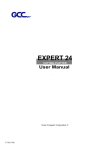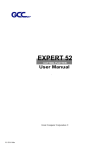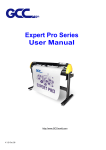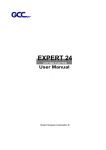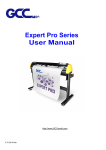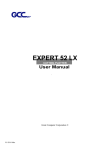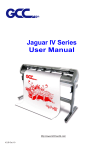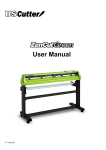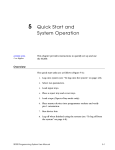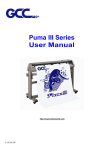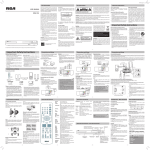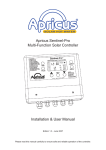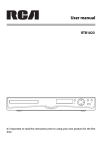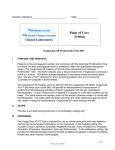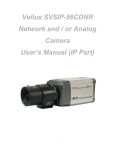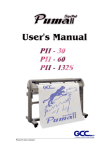Download User Manual - Synergy 17
Transcript
BENGAL CUTTING PLOTTER User Manual ` Great Computer Corporation © V 2.1 Oct. 10 NOTICE GCC reserves the right to modify the information contained in this user manual at any time without prior notice; un-authorised modification, copying distribution or display is prohibited. All comments, queries or suggestions concerning this manual please consult with your local dealer. V 2.1 Oct. 10 Bengal user manual Important Information Thank you for purchasing the Bengal Cutting Plotter. Before you use the cutting plotter, please make sure that you have read the safety precautions and instructions below. ! Caution ¾ SAFETY PRECAUTIONS! For safety concern, please always hold the cutter firmly from the bottom while moving it. Do not move the cutter by clasping the depression area on both sides. O (correct) X (Incorrect) ¾ Do not shake or drop the blade holder, a blade tip can fly out. ¾ During an operation, do not touch any of the moving parts of this machine (such as the carriage). Also be careful to make sure that clothing and hair do not get caught. ¾ ¾ Always connect the power cable to a grounded outlet. Always use the accessory power cable which is provided. Do not wire the power cable so that it becomes bent or caught between objects. ¾ Do not connect the power cable to branching outlet to which other machines are also connected, or use an extension cable. There is danger of overheating and of mis-operation of the machine. ¾ Keep the tools away from children where they can reach. ¾ Always put the pinch rollers within the white marks. Important Information Bengal user manual Table of Contents Important Information 1. General Information 1.1 Package Items 1.2 Product Features 1.3 The Appearance 2. Installation 2.1 Precaution 2.2 Stand 2.3 Blade Installation 2.4 Media Loading 2.5 Cable Connections 2.5.1 USB Interface 2.5.2 How to switch the USB mode 2.5.3 RS-232 Interface 3.Operation 3.1 3.2 3.3 3.4 The Control Panel VLCD File Uploader Data Transmission 1-1 1-1 1-2 2-1 2-2 2-5 2-7 2-8 2-9 2-12 2-12 3-1 3-3 3-6 3-7 4. Basic Maintenance 4.1 Cleaning the cutting Plotter 4.2 Cleaning the Grid Drum 4.3 Cleaning the Pinch Rollers 4-1 4-1 4-2 5. Trouble Shooting 5.1 What if Bengal cannot Operate? 5.2 Light Indicators 5.3 Cutting Quality Problems 5-1 5-1 5-4 Appendix A-1 CorelDraw instruction A-2 Bengal Specification A-3 Blade Specification Table of Contents A-1 A-2 A-3 Bengal user manual 1. General Information 1.1 Package Items The package of Bengal-60 contents the items listed below, please check carefully. If you find any item missing, please consult your local dealer for further assistance. Item Cutting Plotter Accessories 1. Installation CD Quantity 1 Set 1 Set 3. Desktop Support Brackets 2. AC Power Cord 4. Cutting Pad 5. USB Cable 6. RS-232 Cable 7. Printer Cable 8. Tweezers 9. Paper Slicer 10. Error-Condition Label 1.2 Product Features The followings are the main features of the Sable cutting plotters: ‧ Tri-port connectivity – USB & Serial interface. ‧ Up to 400-gram cutting force. ‧ Up to 600 mm/per second cutting speed. General Information 1-1 Bengal user manual 1.3 The Appearance (BN-60) 1.3.1 The Front View A B C D E F G H 【Figure 1-1】 Object A Primary Pinch Roller B Slicing Groove C Alignment Ruler D Tool Carriage E Blade Holder F Platen G Cutting Pad H Control Panel Description To help hold the media during cutting. To help slice off media.. To align media with clear guideline marks To help perform cutting job with installed blade or pen. To hold the blade. The surface for holding and supporting media in operation. To protect blade and plate in operation. To consist of 10 control keys and 4 LED lights. 1.3.2 The Back View I 【Figure 1-2】 Object I Grid Drum General Information Description To move media back and forth in operation. 1-2 Bengal user manual 1.3.3 The Side Views J K L M 【Figure 1-3】 Object J AC Power Connector K Fuse L Power Switch M USB Connector N Parallel Connector O Serial Interface Connector General Information N O 【Figure 1-4】 Description To insert the AC power cord. 3Amp. To turn on or off the machine. To connect the machine and a computer through a USB cable. To connect the machine and a computer through a printe cable. To connect the machine and a computer through a RS-232 cable. 1-3 Bengal User Manual 2. Installation 2.1 Precaution Please read below information carefully before you start installation. Notice 1 z Make sure the power switch is off before installing the cutting plotter. z Carefully handle the cutter to prevent any injuries. Notice 2 Choosing a proper place before setting up the cutting plotter Before installing your cutting plotter, select a suitable location, which meets the following conditions. z The machine can be approached easily from any direction. z Keep enough space for the machine, accessories and supplies. z Keep the working area stable, avoiding sever vibration. z Keep the temperature between 15 and 30℃ (60-86oF) in the workshop. z Keep the relative humidity between 25% and 75% in the workshop. z Protecting the machine from dust and strong air current. z Preventing the machine from direct sunlight or extremely bright lighting. Notice 3 Connecting the Power Supply Check the plug of the power cord to see if it mates with the wall outlet. If not, please contact your dealer. z Insert the plug (male) into a grounded power outlet. z Insert the other end (female) of power cord into the AC connector of cutting plotter. Installation 2-1 Bengal User Manual 2.2 Stand 2.2.1 Stand Installation Please follow the procedures below for assembling the stand and the media support system. Step 1 Please examine supplied items in the accessory box of stand carton before you install: Stand is an optional item. Item List: z 1 Left side vertical stand z 1 Right side vertical stand z 1 Support for left side z 1 Support for right side z 1 Stand Beam z 2 Bottom Stands with wheels z 2 Sliding brackets for paper takeup z 1 Hex Wrench (M5)Φ4 z 28 Socket flat head screws(M6*12L) z 1 Installation Guide Step 2 Position the support for the left side perpendicularly to part Xand put the screws into the holes and tighten them to form a left side T-stand (Figure 2-1). Repeat the same steps with the support for the right side. Support for left side X Bottom Stand with wheels Figure 2-1 Step 3 Installation 2-2 Bengal User Manual Place the stand beam upright on the T-stand and put the screws into the holes but do not tighten them at this step. Stand Beam T-stand Figure 2-2 Step 4 Position both the left Support and right Support perpendicularly to the T-stand and put the screws into the holes and tighten them as shown in Figure 2-3. Support for left side Support for right side Figure 2-3 Step 5 Installation 2-3 Bengal User Manual Remove the cutting plotter from the carton. Position the stand under the plotter, and insert the screws into the holes on the bottom of the plotter but do not tighten them up as shown in Figure 2-4. Figure 2-4 Step 6 Tighten the screws of step 4 and step 6. Place the sliding brackets for paper takeup onto the stand beam. sliding brackets for paper takeup Figure 2-5 Installation 2-4 Bengal User Manual 2.3 Blade Installation Figure 2-6 is the illustrator of the blade holder. Insert a blade into the bottom of the blade holder and remove the blade by pushing the pin. Make sure that your fingers are away from the blade tip. Pin Adjustment depth knob Outward ring Figure 2-6 Step 1 Install blade (Figure 2-7). Step 2 Push the blade to the bottom of the blade holder (Figure 2-8). Figure 2-7 Figure 2-8 Step 3 Adjust the blade tip to suitable length by screwing “Blade tip adjustment screw” clockwise or count-clockwise. (Figure 2-9). Figure 2-9 Installation Tips: “The proper length” means the blade’s length is adjusted 0.1mm more than film’s thickness. That is, if the thickness of film is 0.5mm, then blade’s length is properly adjusted 0.6mm and it can completely cut through the film layer yet avoid penetrating the backing. 2-5 Bengal User Manual Step 4 Insert the blade holder into tool carriage. Please note the outward ring of the holder must put into the grooves of carriage firmly (see Figure 2-10), fasten the case (Figure 2-11). Figure 2-10 Figure 2-11 Step 5 Use the reversing steps to remove the blade holder. Step 6 Eject the blade: Push “Blade eject pin” to eject blade when the blade needs to be replaced. Caution The blade will lose its sharpness after a period of usage, the cutting quality m be affected. By increasing the cutting force, it might do the trick. However, the blade is worn out and no longer provides a reliable cutting, you should rep a new one. The blade is consumable and must be replaced as often as neces to maintain the cutting quality. The quality of the blade deeply affects cu quality. So be sure to use a high quality blade to ensure good cutting results. Tips - When to replace a new blade: 9 If the blade is broken, you have to replace a new one. 9 If cutting quality is not as good as usual, you may need to replace a new one. 9 If the material cannot be cut through by higher cutting force, you may need to replace a new one. Installation 2-6 Bengal User Manual 2.4 Media Loading 2.4.1 Loading the Sheet Media To load the media properly, please follow the below procedures: Step 1 Lift the 2 levers at the back side of cutter to raise pinch rollers (Figure 2-12). Figure 2-12 Step 2 Load your media on the platen and slide it under the pinch rollers from either the front side or the backside. The alignment rulers on the platen extension will help you to adjust the media precisely (Figure 2-13). Figure 2-13 Step 3 Then move the pinch rollers manually to the proper position. Be sure the pinch rollers must be positioned above the grid drum. The white marks on the main beam will remind you where the grid drums are (Figure 2-14). White mark Figure 2-15 Figure 2-14 Step 4 Push the lever backward to lower down the pinch rollers (Figure 2-15). Step 5 After turn on the power, the tool carriage will measure the size of the media automatically. And the plotting cutter begins to work. Installation 2-7 Bengal User Manual Note: 9 Always adjust the position with the pinch rollers raised. 9 Move the pinch rollers by applying force at the rear portion of the pinch roller support. 9 DO NOT move the pinch roller by holding its front rubber roller (Figure 2-16). (X) Incorrect Figure 2-16 2.4.2 Loading the Roll Media You can either use the stand with flexible media support system or desktop media support system for roll media. Please refer to Chapter 2.2 for hardware setup, and Chapter 2.4.1 for media loading. 2.5 Cable Connection The cutting plotter communicates with a computer through a USB (Universal Serial Bus), Parallel port (Centronics), or a Serial port (RS-232C). This chapter shows you how to connect the cutting plotter to a host computer and how to set up the computer/cutting plotter interconnection. !! Notice: When USB connection is enabled, serial port will be disabled automatically. Parallel port Serial port USB port Figure 2-17 Installation 2-8 Bengal User Manual 2.5.1 USB Interface Bengal build-in USB interface are based on the Universal Serial Bus Specifications Revision 1.1. ( Operation system of Windows 95, Windows NT don’t support USB ). USB driver installation Caution!! 9 If you are using Windows 2000 / XP / Vista / 7 as your operating system, make sure you log in using the “Administrator” account. Use the USB One-click Installation for quick driver installation. Follow the simple steps below for driver setup. Step 1: Connecting your GCC cutter 1. Connect the USB connector to the machine and then USB driver will installed automatically. NOTE Check that the USB mode option is set to Common USB Mode before running the installation. Step 2: Installing the software (1) Put the installation CD into your CD-ROM. Please make sure that the USB device is connected before you start the driver installation. Installation 2-9 Bengal User Manual (2) Choose the model you want to install from the driver list and click on either the 32 bit or 64 bit driver installation depending on the operating system installed on your computer to start the installation. (The Expert Pro model is used as an illustration in the following steps.) NOTE If you use the Windows 7 / Vista 64 bit program, please note that a pop-up window will be shown upon the initial installation as shown below: Click “Yes” to continue. Installation 2-10 Bengal User Manual (3) Click “Next” (4) The installation will take a few minutes to complete and you will see a message below and click on “OK” upon completion. Enjoy your GCC cutter! Note: (1) If the driver is being installed for a second time, the user will be prompted as to whether a second copy of the driver installation is required. (2) If the user selects yes, a second copy of the driver will be installed. Installation 2-11 Bengal User Manual How to switch the USB mode? Step 1. Press ON/ Offline button to switch to the “offline” status. Step 2. Press “Pause” and “Origin Set” button at the same time and you will find the current status of the USB mode indicated by the three LEDs as shown below. ◎ Flashing ● LED on Operation System Common USB Mode GCC USB Mode Repeat Data Clear Cut Test ● ● ● ◎ ◎ ● A. 【Switching to GCC USB mode】 If you want to switch the USB mode from Common USB mode to GCC USB mode, please press the “Data Clear” button and then press the “origin set” button to finish your set up. B. 【Switching to Common USB mode】 If you want to switch the USB mode from GCC USB mode to Common USB mode, please press the “Cut Test” button and then press the “origin set” button to finish your set up. Step 3. Please re-connect the USB cable and complete the installation. 2.5.3 RS-232 Interface Connecting to the RS-232 (Serial) Port 1. For IBM PC, PS/2 users or compatibles, connect the RS-232C cable to the serial connector of the assigned serial port (COM1 or COM2) of your host computer. 2. Set up the communication parameters (Baud Rate and Data Bits/Parity) to match the setting of software package, refer to chapter 3 – “Misc” key description. Installation 2-12 Bengal user manual 3. Operation 3.1 The Control Panel 3.1.1 The Outline of control panel Figure 3-1 Key Function POWER LED To indicate the power status ( light up: power on; light off: power off ) ERROR LED To indicate the error status ( light up: error; light off: normal ) To switch modes or stop cutting job( light up: on-line; light off: off-line ) ON/OFF LINE While in on-line mode: only ON/OFF LINE and PAUSE keys activated While in off-line mode: the settings in VLCD can be adjusted. PAUSE To temporarily halt cutting process or to continue REPEAT To repeat last job. DATA CLEAR To clear up buffer memory. CUT TEST To perform cutting tests in different ways. 1. To reset origin at a new position in off-line mode. ORIGIN SET 2. To perform Media Sizing in on-line mode. 4 Arrow Keys To move carriage position, select function, or change setting. 3.1.2 Reset Origin Note: 9 Make sure the machine is in off-line mode to enable this function. Operation 3-1 Bengal user manual Step 1 Move the carriage to a new position. Step 2 Press the ORIGIN SET button to reset origin. 3.1.3 Media Sizing Note: 9 Make sure the machine is in on-line mode to enable this function. Step 1 Load media onto appropriate position. Step 2 Press the ORIGIN SET button to perform Media Sizing. 3.1.3 Cut Test Note: 9 Make sure the machine is in off-line mode to enable this function. 9 It’s recommended to keep performing this function until the cutting quality meets your demand before executing the cutting job. Step 1 After sizing, press the ON/OFF LINE button to set as off-line mode. Step 2 Move the carriage to a preferred position. Step 3 Press CUT TEST button to perform. 3.1.4 Repeat Note: 9 Make sure the machine is in off-line mode to enable this function. Step 1 Press the ON/OFF LINE button to set as off-line mode. Step 2 Press the REPEAT button to perform re-plot function starting at the position where the carriage locates. It is also available to move carriage to a preferred position, re-set origin, and then perform this function. Operation 3-2 Bengal user manual 3.2 VLCD “VLCD” is a computer program to help modify parameters of cutting functions. 3.2.1 Installation Step 1 Copy the VLCD.exe file in the Accessories folder of the Bengal Installation CD onto your local drive to finish installation. Step 2 Launch VLCD by double-click on the icon. 9 9 Make sure the machine is in on-line mode to enable this program. There is media in the machine. Step 3 choose the right port connected to your computer (Figure 3-2). If you are using the USB cable, choose USB0 from the pull down menu. If you are using a Serial cable, choose either COM1 or COM2. Make sure no other devices are occupying the port that you are going to use. 9 9 Make sure the USB driver in the installation CD has been installed before connect VLCD to the cutter by USB option. If the USB driver hasn’t been installed, copy the usbapi.dll file along with VLCD.exe onto a same folder of your local drive to work out. Step 4 Press the Connect button to connect your computer and the cutter. If the connection succeeds, the model info, firmware version, and adjustable parameter columns will be showing (Figure 3-3). Figure 3-2 Operation Figure 3-3 3-3 Bengal user manual 3.2.2 Functions of VLCD Below are the functions adjustable in VLCD for Bengal. Poll Size Force Media Weight Offset Auto Unroll Quality Smooth Media Type Update setting Scaling Poll Size Click on the Poll Size button will reveal the X/Y values. In the case, the maximum plotting length is 25000mm, and the distance between the farthest two pinch rollers is 568.85mm (Figure 3-4). Figure 3-4 Force To adjust the blade force between 0 and 400 (Default = 80g). Media Weight To choose different weights of media in two options: Heavy, and Light (Default). Offset To adjust the blade offset to ensure cutting quality in 8 options: 0.000, 0.175, 0.250, 0.275, 0.300, 0.500, 0.750, and 1.000. Operation 3-4 Bengal user manual Auto Unroll To switch options for sheet media (Auto Unroll: ll: Off) and roll media (Auto Unroll: On default). Quality To choose the cutting quality to either Fine (default) or Draft mode. Smooth To enable or disable (Default) the smoothing cut function. Media Type To choose the media type of Roll media (Default) or single-sheet media. Update Setting To apply the changed setting onto the cutter by press the Update Setting button. Scaling To adjust the scales of XY values to match the real size. Step 1 Enter the width and length of the rectangle that you would like to cut and then press “Scaling Test” (Figure 3-5). Step 2 Measure the real cutting width and length of the rectangle and key in the values in the “STEP 2” boxes. Then press “Calibrate”. Figure 3-5 Operation 3-5 Bengal user manual 9 In case the XY values are typed in error, it’s recommend to close the VLCD program, and re-launch it to keep operating with correct numbers and procedure. Otherwise, the wrong values may affect the accuracy and cause function failure. 3.3 File Uploader 3.3.1 Installation 9 “File Uploader” is a tool to help loading files for direct output. 9 9 The program ONLY supports HPGL format-files generated via GCC Cutter driver. Copy the GCC File Uploader.exe file in the Accessories folder of the Bengal’s Installation CD onto your local drive to finish installation. 9 Launch GCC File Uploader by double-click on the icon (Figure 3-11). Figure 3-11 Figure 3-12 Port setup 9 This function will be activated while choosing COM port for data transmission. 9 Press the Port setup button to pop up the setup window for parameter change (Figure 3-12). 3.3.2 Functions of File Uploader Repeat 9 Activate this function by click on the Repeat’s checkbox. 9 Repeat Delay – the pause time between jobs; Unit: second. 9 Repeat Counts – the number of repeat jobs. Operation 3-6 Bengal user manual 3.4 Data Transmission There are two options to transmit the data from the computer to the cutting plotter: Option 1: With proper interface settings, the data can be transmitted from your application software package to the cutting plotters directly. Option 2: Most cutting software packages are able to emulate HP-GL or HP-GL/2 commands, therefore. As long as the file is HP-GL or HP-GL/2 format, the cutting plotter can output the data precisely. Operation 3-7 Bengal User Manual 4. Basic Maintenance This chapter explains the basic maintenance (i.e. cleaning the cutting plotter) required for the cutting plotter. Except for the steps mentioned below, all the other maintenances must be performed by a qualified service technician. 4.1 Cleaning the cutting plotter In order to keep the cutting plotter under good conditions and have the best performance, you need to clean the machine properly and regularly. Precaution in Cleaning Unplug the cutting plotter before cleaning. Never use solvents, abrasive cleaners or strong detergents for cleaning. They may damage the surface of the cutting plotter and the moving parts. Recommended Methods Gently wipe the cutting plotter surface with a lint-free cloth. If necessary, clean it with a water-rinsed or an alcohol-rinsed cloth. Wipe the cutting plotter to remove any residues on the cutting plotter. Finally absorb water with a soft, lint-free cloth. Wipe all the dust and dirt from the tool carriage rail. Use a vacuum cleaner to clean any accumulated dirt and media residue beneath the pinch roller housing. Clean the platen, paper sensors and the pinch rollers with a water-rinsed cloth or alcohol-rinsed cloth. Finally absorb water with a soft, lint-free cloth. Use the same method mentioned above to clean dust and dirt from the stand. 4.2 Cleaning the Grid Drum Turn off the cutting plotter, and move the tool carriage away from the area needed to be cleaned. Raise the pinch rollers and move them away from the grid drum for cleaning. Use a bristle (a toothbrush is also acceptable) to remove dust from the drum surface. It needs to rotate the drum manually to clean the drum completely (Figure 5-1). Basic Maintenance 4-1 Bengal User Manual Figure 4-1 4.3 Cleaning the Pinch Rollers If the pinch rollers need a thorough cleaning, use a lint-free cloth or cotton swab to wipe away the accumulated dust from the rubber portion of the pinch rollers. To prevent the pinch rollers from rotating while cleaning, use your fingers to hold the pinch rollers in place. Use a lint-free cloth or cotton swab rinsed with alcohol to remove the embedded or persistent dust. Basic Maintenance 4-2 Bengal User Manual 5. Trouble Shooting This chapter helps you to correct some common problems you may come across. Prior to getting into the details of this chapter, please be sure that your application environment is compatible with the cutting plotter. Note: Before contacting your local dealer, please make sure that the problems are coming from your cutting plotter, not from the communication between the computer and cutting plotter or from a malfunction in your computer or software. Why doesn’t the cutting plotter operate? 5.1 What if Bengal cannot operate? If your cutting plotter doesn’t plot, please check the following items first: Is the power cord plugged in properly? Is the power cord connected to the power connector properly? Is the power switch turned on properly? Solutions: If the POWER LED lights on, the cutting plotter should be in a normal condition. Turn off the cutting plotter and turn it on again to see if the problem still exists. If the POWER LED doesn’t light, please call your local dealer to resolve this problem. 5.2 Light Indicators Some of the operating problems can be identified by the lights on the control panel. When your cutting plotter stops operating or the lights are on or flashing unexpectedly, see the following descriptions of the panel light patterns and the actions you should take. Trouble Shooting 5-1 Bengal User Manual 5.2.1 Warning Indicators When the ERROR LED flashes (as shown below), take the necessary actions according to the following instructions. When the problems are solved, the ERROR LED will turn off automatically. Pressing the ON/OFF LINE button can also turn off the ERROR LED. Warning Indicators 1 Graph was clipped 2 HPGL/2 command Error 3 Lever up or no media 4 Cannot repeat 5 Communication error 6 Width sensor error 7 Check media, drum or X motor = flash = on ERROR ON/OFF LINE REPEAT DATA CUT CLEAR TEST = off Warning 1 The graph is clipped This condition indicates that the cutting graph is bigger than the cutting area. You can solve the problem by: 1. Reload a wider or longer media. 2. Move the pinch rollers to widen the cutting area. 3. Re-scale the graph to a smaller size. Then send the cutting job again from your computer to the cutting plotter. Warning 2 HPGL/2 command error If the cutting plotter cannot recognize the commands from your computer, please check the commands applied to your cutting plotter in the HP-GL/2 or HPGL commands. Then send the same job to the cutting plotter again. If that doesn’t solve the problem, please contact your local dealer. Warning 3 Lever up or no media Check that you have lowered the lever down and make sure that you load the media before cutting. Trouble Shooting 5-2 Bengal User Manual Warning 4 Cannot repeat cutting There are two possibilities: 1. There is no data in the buffer: please send the job again from your computer; 2. The buffer is full: please send the same job from your computer again. Under both conditions, press the ON/OFF LINE key to clear the warning message. Warning 5 Communication error Check that the serial/USB/parallel cable has been connected to the cutting plotter and computer properly. If so, then check whether the interface settings are correct. Check that the communication settings in your PC are the same as the ones on your cutting plotter (for example – 9600bps, no parity, 8 bits, 1 stop bit). Then, press ON/OFF Line key to switch back to On Line mode. Warning 6 Width sensor error Check that the pinch rollers are positioned above the grid drum and reload the media again. Note: In order to identify the warning messages easily, please stick the warning sticker (in accessory box) on the side cover of your cutting plotter. 5.2.2 Error Indicators If some mechanical problems occur during the operation, the ERROR LED will turn on. Please follow the instructions below to solve the problem. If the cutting plotter still cannot work, please contact your local dealer and tell him or her about the error indicator. Error Indicators 1 SRAM error 2 DRAM error 3 Check media, drum, or X motor 4 Check media or Y motor = flash = on ERROR ON/OFF LINE REPEAT = off Error 1 and 2 Please contact your local dealer to replace SRAM or DRAM. Trouble Shooting 5-3 DATA CUT CLEAR TEST Bengal User Manual Error 3 Check the media, drum or X-motor (Drum driven motor) This message indicates that there might be a problem on the X-axis. Please check that the drums are working normally and see that the media is well loaded. Then turn on the power and reboot the cutting plotter. Error 4 Check the media, or Y motor (carriage driven motor) This message indicates that there might be an obstruction to the carriage relating to a problem on the Y-axis. Please clear the obstruction and check that the carriage can move smoothly. Then turn on the power and reboot the cutting plotter. 5.3 Cutting Quality Problems Check pen installed correctly and the blade holder fastened securely No Yes Please refer to Chpater 2. Is the blade broken? No Yes Check tool force setting Replace a new blade Yes No Please refer to 3.23 " Cutting Test" to adjust the tool force. Is there any dirt adhered to the blade No Yes Remove the blade and clean it Trouble Shooting 5-4 Please contact customer service persionnel for technical support Bengal User Manual Appendix - Bengal Specification Model BN-60 Max. Cutting Width 600mm (23.6") Max. Media Width 719mm (28.3") Drive DC Servo Control Material Thickness 0.8mm Max. Cutting Force 400g Max. Cutting Speed(Diagonal) 600 mm/sec (23.6"/sec) Software Resolution 0.025 mm Repeatability ±0.1mm Buffer Capacity 500 KByte Interfaces USB 1.1, Parallel,& Serial Commands HP-GL, HP-GL/2 Configurable Origin Yes Control Panel 6 LEDs/10 Keys Stand Optional Operation Environment z Appendix Temperature Humidity 10°C~35°C / 50°F~95°F 25% ~ 75% The above specification is subject to change without prior notice. A-I Bengal User Manual CorelDRAW Output Instruction The following is an example of how to output the file with CorelDRAW. User Instructions 1. Open CorelDRAW, finish editing all the files you wish to plot and select all the images at once. 2. Select “Outline Pen” to adjust the outline for cutting. 3. Adjust the value of pen width to 0.001 mm and click “OK” to save your input. CorelDRAW Plug-In A-3 Bengal User Manual 4. Select “ File → Print” to output the file to your cutters. 5. Choose the correct model you have installed. CorelDRAW Plug-In A-3 Bengal User Manual 6. Choose the “Layout page” and click the “Reposition images to: → Bottom left corner”. Please note that you must put your image at the bottom left corner. 7. Go back to the General page and check that your image is at the bottom left corner. Click “Print” and get a wonderful cutting image. CorelDRAW Plug-In A-3 Bengal User Manual Bengal Specification Model BN-60 Max. Cutting Width 600mm (23.6") Max. Media Width 719mm (28.3") Drive DC Servo Control Material Thickness 0.8mm Max. Cutting Force 400g Max. Cutting Speed(Diagonal) 600 mm/sec (23.6"/sec) Software Resolution 0.025 mm Repeatability ±0.1mm Buffer Capacity 500 KByte Interfaces USB 1.1, Parallel,& Serial Commands HP-GL, HP-GL/2 Configurable Origin Yes Control Panel 6 LEDs/10 Keys Stand Optional Temperature 15°C~30°C / 60°F~86°F Operation Environment 25% ~ 75% Humidity z Compatible with Windows 2000/XP/7. z The specification and data sheet may vary with different materials used. In order to obtain the best output quality, please maintain the machine regularly and properly. z GCC reserves the right to change the specifications at any time without notice Appendix A-I Bengal User Manual Blade Specification 20200159G For cutting thick fluorescent and reflective vinyl. Also for cutting detailed work in standard vinyl. The blade is 45° with Red Cap(5-unit package), 0.25 mm offset For cutting reflective vinyl, cardboard, sandblast, flock, and stencil sharp edge. 26500058G The blade is 60° with Green Cap, 0.50 mm blade offset For cutting thin sandblast mask and stencil with friction feed or sprocket feed machine. 26500059G The blade is 60° with Blue Cap, 0.25 mm blade offset For Cutting small text and fine detail. Sharp blade with smallest offset. 26500060G The blade is 0.175 mm blade offset with Black Cap Blade Specification A-2 Bengal User Manual About the Tool A generic term referring to the blade that cuts the sheet, the pen that does plotting, and the LED bombsight (option) used for pointing to the reference point. OFFSET is the distance that the blade tip is displaced from the centerline of the blade. Blade Central line Blade tip offset Protrusion Length of the Blade Thickness of the media (t1) Protrusion length of the blade Thickness of the base paper (t 2) Length of protrusion = t1 + t 2/ 2, but for your convenience you may just make it about 0.3mm ~ 0.5mm beyond the blade holder tip. Blade Specification A-2








































